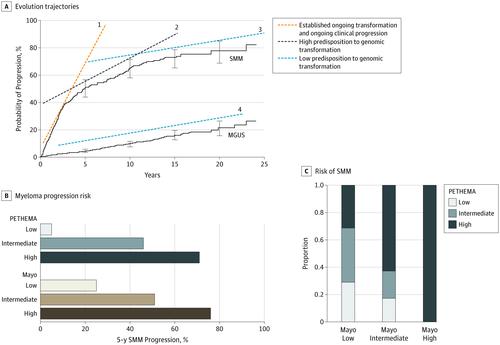JAMA Oncology ( IF 22.5 ) Pub Date : 2020-03-01 , DOI: 10.1001/jamaoncol.2019.4659 Francesco Maura 1, 2 , Niccolò Bolli 3, 4 , Even H Rustad 1 , Malin Hultcrantz 1 , Nikhil Munshi 5, 6 , Ola Landgren 1

|
Importance All patients who develop multiple myeloma have a preceding asymptomatic expansion of clonal plasma cells, clinically recognized as monoclonal gammopathy of undetermined significance or smoldering multiple myeloma (SMM). During the past decade, significant progress has been made in the classification and risk stratification of SMM.
Observations This review summarizes current clinical challenges and discusses available models for risk stratification in the context of SMM. Owing to several novel, more effective, and less toxic drugs, these aspects are becoming increasingly important to identify patients eligible for early treatment. However, all proposed criteria were built around indirect markers of disease burden and therefore are generally able to identify a fraction of patients with SMM in whom transformation to multiple myeloma and genomic subclonal diversification are already happening. In contrast, next-generation sequencing approaches have the potential to identify myeloma precursor disease that will progress even before the major clonal expansion and progression, providing a potential base for more effective treatment and better precision regarding the optimal timing of treatment initiation.
Conclusions and Relevance Owing to modern technologies, in the near future, prognostic models derived from genomic signatures independent of the disease burden will allow better identification of the optimal timing to treat a plasma cell clonal disorder at the very early stages, when the chances of eradication are higher.
中文翻译:

从闷烧的骨髓瘤的癌症负担转移到癌症基因组学:综述。
重要性 所有发展为多发性骨髓瘤的患者均具有无症状的克隆性浆细胞无症状扩张,临床上认为其意义不明或患有阴郁的多发性骨髓瘤(SMM)。在过去的十年中,SMM的分类和风险分层取得了重大进展。
观察结果 这篇综述总结了当前的临床挑战,并讨论了在SMM背景下可用于风险分层的模型。由于几种新颖,更有效且毒性较小的药物,这些方面对于确定有资格接受早期治疗的患者变得越来越重要。但是,所有拟议的标准都是围绕疾病负担的间接标记物建立的,因此通常能够确定一部分SMM患者已经发生向多发性骨髓瘤的转化和基因组亚克隆多样化。相比之下,下一代测序方法有可能识别甚至在主要的克隆扩增和进展之前仍会进展的骨髓瘤前体疾病,
结论和相关性 由于现代技术的发展,在不久的将来,从基因组特征中独立于疾病负担的预后模型将使人们能够更好地确定在最早期阶段根除浆细胞克隆性疾病的最佳时机,这时根除的机会就很大。更高。











































 京公网安备 11010802027423号
京公网安备 11010802027423号